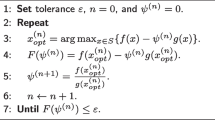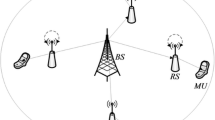Abstract
Wireless full-duplex transmission has the potential to double the system throughput compared with the conventional half-duplex transmission. To achieve the maximum potential system throughput, optimal power allocation taking into account quality-of-service (QoS) is urgently needed. In this paper, we propose the QoS driven power allocation schemes for wireless full-duplex bidirectional links. By integrating information theory with the statistical QoS principle, we build two models — local transmit power related self-interference (LTPRS) model and local transmit power unrelated self-interference (LTPUS) model to analyze the wireless full-duplex transmission. For both of these two models, we derive the optimal power allocation schemes, which aim at maximizing the system throughput subject to the given delay-QoS constraint, over wireless bidirectional links with full-duplex transmission. The analyses and numerical results verify that our proposed power allocation scheme can efficiently support diverse QoS requirements over wireless bidirectional links. Our proposed fullduplex QoS driven power allocation schemes can obtain larger effective capacity compared with the conventional half-duplex transmission over wireless bidirectional links.
Similar content being viewed by others
References
Bliss D W, Parker P A, Margetts A R. Simultaneous transmission and reception for improved wireless network performance. In: Proceedings of IEEE on Statistical Signal Processing, Madison, 2007. 478–482
Riihonen T, Werner S, Wichman R. Comparison of full-duplex and half-duplex modes with a fixed amplify-and-forward relay. In: Proceedings of IEEE Wireless Communications and Networking Conference, Budapest, 2009. 1–5
Radunovic B, Gunawardena D, Key P, et al. Rethinking indoor wireless mesh design: low power, low frequency, full-duplex. In: Proceedings of 5th IEEE Workshop on Wireless Mesh Networks, Boston, 2010. 1–6
Gollakota S, Katabi D. Zigzag decoding: combating hidden terminals in wireless networks. In: Proceedings of the ACM SIGCOMM 2008 Conference on Data Communications, New York, 2008. 159–170
Choi J I, Jain M, Srinivasan K, et al. Achieving single channel, full duplex wireless communication. In: Proceedings of 16th Annual International Conference on Mobile Computing and Networking, New York, 2010. 1–12
Jain M, Choi J I, Kim TM, et al. Practival, real-time, full duplex wireless. In: Proceedings of 17th Annual International Conference on Mobile Computing and Networking, New York, 2011. 301–312
Riihonen T, Werner S, Wichman R. Hybrid full-duplex/half-duplex relaying with transmit power adaptation. IEEE Trans Wirel Commun, 2011, 10: 3074–3085
Cheng W C, Zhang X, Zhang H L. Full/half duplex based resource allocations for statistical quality of service provisioning in wireless relay networks. In: Proceedings of IEEE INFOCOM, Orlando, 2012. 864–872
Wu D P, Negi R. Effective capacity: a wireless link model for support of quality of service. IEEE Trans Wirel Commun, 2003, 2: 630–643
Tang J, Zhang X. Quality-of-service driven power and rate adaptation over wireless links. IEEE Trans Wirel Commun, 2007, 6: 3058–3068
Zhang X, Du Q. Cross-layer modeling for QoS-driven multimedia multicast/broadcast over fading channels. IEEE Commun Mag, 2007, 45: 62–70
Du Q, Zhang X. Statistical QoS provisionings for wireless unicast/multicast of multi-layer video streams. IEEE J Sel Area Commun, 2010, 28: 420–433
Wang J, Chen J. Performance of wideband CDMA systems with complex spreading and imperfect channel estimation. IEEE J Sel Areas Commun, 2001, 19: 152–163
Riihonen T, Werner S, Wichman R. Optimized gain control for single-frequency relaying with loop interference. IEEE Trans Wirel Commun, 2009, 8: 2801–2806
Young T K, Joon H C. Capacity of MIMO wireless channel with full-duplex amplify-and-forward relay. In: Proceedings of IEEE 20th International Symposium on Personal, Indoor and Mobile Radio Communications, Tokyo, 2009. 117–121
Chang C S. Stability, queue length, and delay of deterministic and stochastic queueing networks. IEEE Trans Autom Control, 1994, 39: 913–931
Author information
Authors and Affiliations
Corresponding author
Rights and permissions
About this article
Cite this article
Cheng, W., Zhang, H. Quality-of-service driven power allocations for wireless full-duplex bidirectional links. Sci. China Inf. Sci. 57, 1–10 (2014). https://doi.org/10.1007/s11432-013-4986-3
Received:
Accepted:
Published:
Issue Date:
DOI: https://doi.org/10.1007/s11432-013-4986-3




